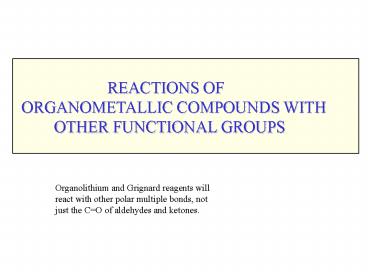Organolithium and Grignard reagents will - PowerPoint PPT Presentation
1 / 13
Title:
Organolithium and Grignard reagents will
Description:
Organolithium and Grignard reagents will. react with other polar multiple bonds, not. just the C=O of aldehydes and ketones. REACTIONS OF. ORGANOMETALLIC COMPOUNDS ... – PowerPoint PPT presentation
Number of Views:645
Avg rating:3.0/5.0
Title: Organolithium and Grignard reagents will
1
REACTIONS OF ORGANOMETALLIC
COMPOUNDS WITH OTHER FUNCTIONAL GROUPS
Organolithium and Grignard reagents will react
with other polar multiple bonds, not just the CO
of aldehydes and ketones.
2
REACTIONS WITH NITRILES
A synthesis of ketones.
3
NITRILES YIELD KETONES
d-
d
..
-
Li
H3O
(hydrolysis)
a ketone
4
HYDROLYSIS OF THE ADDUCT (AQUEOUS ACID)
-
..
..
Li
..
..
H
-H, H
..
..
..
..
ketone
NH3
NH4
5
REACTIONS WITH ESTERS
A synthesis of tertiary alcohols.
6
UNLIKE ALDEHYDES OR KETONES ESTERS REACT TWICE !
..
Li
-
reacts once
..
-
O-CH3
..
H3O
leaving group
reacts again
3o alcohol
7
COLLAPSE OF THE INTERMEDIATE
bond is highly polar - not strong
The same is true for Mg (Grignard complex).
..
-
The tetrahedral intermediate collapses easily,
because the bond to Li is not strong.
The leaving group RO- is expelled.
8
THE VERSATILITY OF ORGANOMETALLIC COMPOUNDS
Alkyllithium compounds and Grignard reagents
R-Li and R-Mg-X
RLi or RMgX plus
Yields
formaldehyde
primary alcohols
other aldehydes
secondary alcohols
ketones
tertiary alcohols
nitriles
ketones
carbon dioxide
carboxylic acids
esters
tertiary alcohols
9
AMIDES AND ACIDS DO NOT REACT
THEY HAVE ACIDIC HYDROGENS
10
ORGANOCADMIUM REAGENTS
Synthesis of ketones from esters and acid
chlorides.
11
ORGANOCADIUM REAGENTS
They are made by adding CdCl2 to a Grignard
reagent
ether
R-Mg-Cl CdCl2 R-Cd-R
MgCl2
Organocadmium reagents are less reactive toward
esters than Grignard reagents.
They only react once.
12
ORGANOCADMIUM REAGENTS DO NOT REACT TWICE
WITH ESTERS
..
Cd-R
reacts once
workup
H3O
-
O-CH3
..
ketone
HO-CH3
Acid chlorides also react this way.
13
STABLE TETRAHEDRAL COMPLEX
The bond has more covalent character than a bond
to Li or Mg - it is stronger.
-
Apparently the tetrahedral intermediate does not
collapse (expel the leaving group) during the
reaction. It breaks down on hydrolysis, and
then the leaving group is expelled.






























